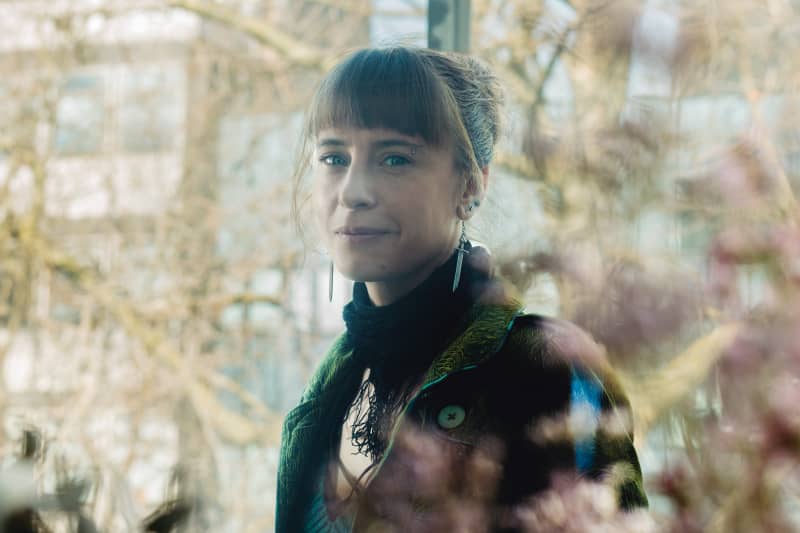Can we really make flying green?

CO₂ emissions from the aviation industry are expected to triple by 2050. But rather than suggesting we give up flying altogether, the Imperial community is working on some clever – and surprising – solutions.
When a 24-hour deluge hit the city of Mumbai in 2005, Swapnil Jagtap (PhD Civil Engineering 2022) wasn’t unduly worried. The city rarely flooded, he reasoned, and even when it did, his flat was not affected. This time, though, was different.
The water rose and rose, and by the time the storm ended, his home was under five feet of water – and the city was devastated. This was the first time Jagtap was exposed to the change in weather patterns brought about by climate change – but it wouldn’t be the last.
In 2017, in Orlando, Florida, he witnessed a level three hurricane: the local community was without power for a week. “And, of course, as someone from a tropical climate, I always thought European heatwaves were weak,” he says. “Not anymore. We need to act on climate change, and I always wanted to use my engineering skills for something impactful, something big. That’s why today, my research is focused on sustainable aviation.”

FIG 1: FOSSIL FUEL
A Boeing 747 uses approximately one gallon of fuel every second and is a significant contributor to climate change.
Right now, decarbonising air travel is one of our biggest challenges – aviation contributes around 3.5 per cent of the total manmade climate forcing across all industries.
This doesn’t seem like a lot, says Rafael Palacios, Professor of Computational Aeroelasticity at the Department of Aeronautics and Director of the Brahmal Vasudevan Institute for Sustainable Aviation, “but then, you realise that everyone has a plan for decarbonisation apart from some very hard-to-decarbonise sectors, aviation being one of them. Aviation is unlikely to be net zero by 2050 – planes have a lifespan of more than 20 years, so we should already be building those sustainable planes by now. The technology is clearly behind the curve.”
And that is what the Brahmal Vasudevan Institute for Sustainable Aviation, Imperial’s flagship multidisciplinary research centre in net zero aviation technologies, is hoping to change. Established with a visionary £25 million gift from Brahmal Vasudevan (Aeronautical Engineering 1990), founder and CEO of private equity firm Creador, and his wife Shanthi Kandiah, founder of legal firm SK Chambers, it opened in 2022.
Professor Rafael Palacios, Professor in Computational Aeroelasticity at the Department of Aeronautics.
Professor Rafael Palacios, Professor in Computational Aeroelasticity at the Department of Aeronautics.
The Institute is focused on maintaining the benefits of aviation in a way that continues to be safe, accessible and sustainable. “We need to be able to quantify the adverse impacts of aviation on the environment, rethink the way flying currently works within the wider transport system, and propose sustainable solutions valid across the full life cycle of the aviation system,” says Palacios. “Sustainable aviation fuels (SAFs) don’t yet exist in the volume they are needed. Right now, there is a competition of ideas – including biofuels, hydrogen and power-to-liquid fuels – and no clear winners. The Institute will be the perfect place for all these ideas to come together."

FIG 2: POWERED BY ELECTRIC
Batteries and electric motors drive propellers or turbines that provide zero emissions and quieter flights.
Jagtap, who was funded by the President’s PhD Scholarship, was named one of Forbes’ 30 under 30 for one of those ideas: a PhD focused on his new hydrogen aircraft design. Picture an aeroplane and most of us picture a tube wing aircraft, such as a Boeing 777 – essentially a tube with wings. A version of that design capable of carrying cryogenic hydrogen tanks would have to have a fuselage 40 per cent bigger. Or you could design something entirely different, as Jagtap did: a blended wing body aircraft. It sounds dry but the reality is beautiful: a hydrogen-powered aircraft with zero emissions where the wings and the fuselage are a single object: a manta ray of the skies.
Swapnil Jagtap, Postdoctoral research fellow of the IDEAS Lab at the University of Michigan.
Swapnil Jagtap, Postdoctoral research fellow of the IDEAS Lab at the University of Michigan.
Of course, designing such an aircraft is one thing; building it and scaling the systems needed to get it working globally is quite another. Jagtap emphasises that his work is at the conceptual state and, as yet, he hasn’t published his research, though he is hoping to do so later this year. Hydrogen isn’t a magic potion, either: it comes with its own problems.
While hydrogen combustion has zero carbon emissions and creates lesser contrails – the white streaks an aircraft leaves in the sky, which contain harmful particles – producing it conventionally is sufficiently carbon-intense to wipe out any gains.
Airports don’t currently have the infrastructure to handle large quantities of hydrogen either, as it has to be handled in a cryogenic state. “But hydrogen can be produced in 59 different ways – and biofuels in 58 – so I explored these
different ways in my PhD and the best routes we can use to produce these alternative fuels,” says Jagtap. “This helps fuel manufacturers to focus their efforts, improving supply chain and manufacturing efficiency.”
In the absence of abundant and affordable SAFs coming online any time soon, finding ways of burning less conventional fuel is vital. Palacios’s own work seeks to find new ways for planes to be efficient: to free aviation from the constraints of its traditional design concepts. Using computational modelling, he examines what fuel efficiency might look like if those parameters are changed.
What would happen, for example, if wings were much, much longer and thinner? Greater aerodynamic efficiency for a start, he says. “Of course, now you have wings that are 60 metres long, when before they were 30 metres long. That has challenges – firstly, they wouldn’t fit in one of today’s airports. But they outperform current airplanes in terms of fuel efficiency. So, you need much less fuel for the same performance.” He is currently working with Airbus on a possible solution to the airport problem: folding wings.

FIG 3: HEAVY AIRCRAFT
The average commercial aircraft weighs between 153 and 220 tons, causing huge amounts of CO2 emissions.
Another key to better fuel efficiency, he says, is using software to shape the aerodynamic environment. Right now, planes are designed to passively sustain whatever comes their way – turbulence, wind and snow. These new software
solutions would allow planes to reconfigure themselves according to conditions. (If you have noise-cancelling headphones, Palacios points out, then you’ll already have benefited from this idea.) “And that gives you a huge improvement in performance – 20 per cent plus. It’s not a micro improvement. It’s a fundamental change.”
Meanwhile, Silvestre Pinho, Professor in the Mechanics of Composites, is developing numerical models of new wing designs that can accurately predict how they would react in real-life situations, enabling more fuel-efficient designs to get to market sooner. These models will also enable new innovations to be tested, such as the effect of installing hydrogen tanks. “Shaving a few years from an aircraft development cycle –especially if it’s an innovative aircraft development cycle – is hugely important,” he says.
Professor Silvestre Pinho, Professor in the Mechanics of Composites at the Department of Aeronautics.
Professor Silvestre Pinho, Professor in the Mechanics of Composites at the Department of Aeronautics.
But a change this big won’t happen just by working in the lab, so much of Pinho’s time is spent on advocacy and policymaking: speaking to MPs, MEPs, industry and think tanks. “Talking to policymakers is absolutely paramount. Whether we get to net zero in aviation or not depends on political choices. We need investment to develop aircraft and flight path management – flying at different heights in different atmospheric conditions, for example – to reduce the effect of contrails, which make up about half the warming effect. Policy should be informed by actual technical data, and it is the duty of universities and researchers to get that message across.”

FIG 4: LIGHTER AIRCRAFT
The design of much thinner, fold-up aircraft wings helps reduce carbon capture by more than 60 per cent.
And finally, efforts are – literally – getting off the ground. Last November, a Virgin Atlantic Boeing 787 became the first plane to fly from London Heathrow to New York JFK Airport powered entirely by SAF. The Virgin Atlantic-led project, Flight100, involved a consortium including Imperial, Boeing and BP, and set out to demonstrate that SAF is a viable alternative to regular jet fuel. Working on the
project was Georgia Gamble, whose PhD at Imperial is examining the health impact of particulate matter generated from a burner – which she designed – that models aviation emissions.
Georgia Gamble, is a PhD student in Aviation, Health and Sustainability, and specifically combustion aerosol toxicology.
Georgia Gamble, is a PhD student in Aviation, Health and Sustainability, and specifically combustion aerosol toxicology.
Traditional combustion engines have been subject to considerable scrutiny – but aviation, says Gamble, has avoided monitoring of aerosols up until recently, partly because it’s much harder to do. “You can’t really put a monitoring set-up next to an aircraft engine as it’s obviously dangerous. But now, we are starting to look at how we might be able to do it safely.” Gamble was able to collect emissions from an auxiliary power unit using the fuels for Flight100, which she then tested on a model of lung cells. “We have had some very interesting results, which we hope to publish soon. We believe we are the first to look in detail at the health impacts of SAFs. It’s great to feel that we could have a direct impact on what is hopefully going to be the future of aviation.”
These are grand challenges indeed – but there has never been a better time to work on the cutting edge in this sector. “Is it daunting?” says Palacios. “Yes. But I’m an engineer. I thrive on technical challenges and uncertainty.” Pinho agrees: “We are probably in the most exciting time since the development of the jet engine in the 1930s and 40s, which transformed aviation. Now, with the transition to net zero, we are looking at another huge shift in technology that changes things completely. The future is incredibly exciting.”
Imperial is the magazine for the Imperial community. It delivers expert comment, insight and context from – and on – Imperial's engineers, mathematicians, scientists, medics, coders and leaders, as well as stories about student life and alumni experiences.
This story was published originally in Imperial 56/Summer 2024.
Read more stories from Imperial 56









